

Geothermal Insider

Ground water controversy, words from a water leader, and more

Annex Publishing & Printing Inc.
P.O. Box 530, Simcoe, Ontario N3Y 4N5 (800) 265-2827 or (519) 429-3966 Fax: (519) 429-3094
editor | Laura Aiken laiken@annexweb.com (416) 522-1595
assistant editor | Karly O’Brien kobrien@annexweb.com (905) 713-4358
sales manager | Ed Cosman ecosman@annexweb.com (519) 429-5199, (888) 599-2228, ext 276
sales assistant | Barb Comer bcomer@annexweb.com (519) 429-5176, (888) 599-2228, ext 235
media designer | Chris Springle cspringle@annexweb.com
Group publisher | Martin McAnulty mmcanulty@annexweb.com
president | Mike Fredericks mfredericks@annexweb.com
Publication Mail Agreement #40065710. RETURN UNDELIVERABLE CANADIAN ADDRESS TO CIRCULATION DEPARTMENT, P.O. BOX 530, SIMCOE, ON N3Y 4N5
e-mail: subscribe@groundwatercanada.com
Printed in Canada, All rights reserved. Editorial material is copyrighted. Permission to reprint may be granted on request. ISSN 0383-7920
Circulation e-mail:
subscribe@groundwatercanada.com Tel: 866-790-6070 ext. 208 Fax: 877-624-1940
Mail: P.O. Box 530, Simcoe, ON N3Y 4N5
Subscription Rates
Canada - 1 Year $42.00 (plus 5% GST - $44.10)
U.S.A. - 1 Year $60.00
Occasionally, Ground Water Canada will mail information on behalf of industry-related groups whose products and services we believe may be of interest to you. If you prefer not to receive this information, please contact our circulation department in any of the four ways listed above. Serving the Canadian ground water industry for 39 years.

Features
10 Geothermal Ins I der
Industry insights from GeoSource Energy’s CEO
18 FrustratIons w Ith Frack I nG Shedding light on fracking and ground water
22 wor ds oF water w I s dom
Meet Bob Sandford, one of Canada’s leading authorities on water
26 proFIts an d petItIons
How bottled water is stirring up ground water sentiments
ON THE WEB:
4 the road past rebates
Education is the long-term key past shuttered government programs
By Laura Aiken
6 Industry news
8 Guest c olumn Great excavations
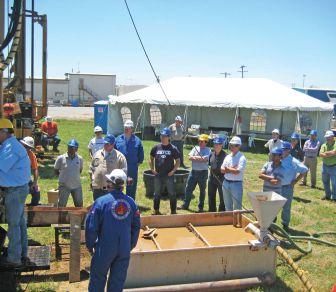


Alberta professor highlights ground and surface water connection University of Calgary professor Masaki Hayashi visited Canmore to give a talk on the issue of sustainable ground water from the watershed perspective.
University given $1M to fund First Nation water research
The University of Guelph will receive $1 million over the next five years from the Royal Bank of Canada in support of water-related research projects for First Nations communities.
www.groundwatercanada.com
The road past rebates
It’s been a whirlwind year for the geothermal industry.

by Laura Aiken
the federal ecoENERGY Retrofit program expired in March 2012, putting an end to government-funded rebates for homeowners who want to invest in renewable energy like geothermal heating and cooling systems. The retrofit program wasn’t the only federal environmental initiative to bite the dust lately. The ecoENERGY Technology Initiative and The Pulp and Paper Green Transformation Program have also shuttered. It seems sustainability is a lower rung on the Harper government’s priority ladder when compared to the development and export of our natural resources, an area where the feds are spilling more than a little loose change. The government increased its budget for natural resources promotion from $9 million in 2011-12 to $16.5 million in 2013-14 (as reported by the Hill Times) to run a series of advertisements designed to help Canadians understand why it’s a good thing to develop the oil and gas industry and how the government is protecting the environment in the process. One could argue that Harper’s foremost energy agenda appears to run more along of the lines of “ resources for sale” than “resources to renew.”
At the end of the day, the geothermal industry can’t depend on what government is willing to do to help it generate business.
Where does this leave the geothermal industry, a promising technology and the theme of Ground Water Canada ’s fall edition? I still found a handful of government programs in place to help investment in geothermal. The ecoENERGY for Aboriginal and Northern Communities Program is scheduled to run until 2016. This program, administered by Aboriginal Affairs and Northern Development Canada, provides financial support for renewable energy for aboriginal and northern community projects. The website currently states that the organization has received a large number of applications and thanks everyone for their patience in awaiting forthcoming funding decisions. There is also a tax credit available to industry for investing
in renewable energy. The Accelerated Capital Cost Allowance for Efficient and Renewable Energy Generation Equipment (Class 43.1) is administered by the Canada Revenue Agency in partnership with Finance Canada, and “provides an accelerated rate of write-off (30 per cent per year, on a declining balance basis) for investments that produce heat for use in an industrial process or electricity by using fossil fuel efficiently or by using renewable energy sources,” as stated by the government online. Geothermal is specifically listed as an eligible alternative energy.
At the end of the day, the geothermal industry can’t depend on what government is willing to do to help it generate business. For commercial and residential installations alike, I have to agree with GeoSource CEO Stan Reitsma when he says that education is the key focus. Responsibility for educating potential customers rests with geothermal industry stakeholders and associations. Businesses and homeowners will need to be motivated by the grand double great that g eothermal gives: economic savings and sustainability. I vote for the retrofit rebates to be revived, but it’s not a premise to move forward on. Associations must continue to lobby for the industry, while its stakeholders shake the grass roots. Now is the time to find ways to reach the public more often, whether it’s through information alliances with new homebuilders or other complementary systems, like greywater recycling, that could perhaps benefit from mutual promotion. We need a sustainable future and the answer could be right in the heat under our feet.
Best to shout it from the rooftops because Canadians are about to get a dose of oil and gas advertising from the highest levels of government. What kind of fight will the geo industry need to stage to compete with that?

@GroundWaterMag
NEXT ISSUE: Our winter edition will focus on drill rigs. Don’t miss it! Have a great fall from all of us at Ground Water Canada.



INDUSTRY NEWS
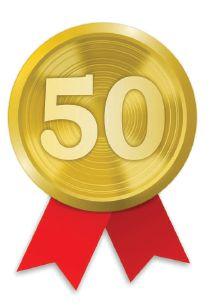
STAU b E r D r I llIN g Ach I EvES 50-yEAr MI lESToNE
Stauber Drilling is celebrating 50 years of installing, servicing and drilling wells in Saskatchewan.
In 1959, Harold Stauber unofficially began his well drilling company by providing water well services to farmers and commercial wells for the hog industry. That same year, he bought a conventional mud rotary rig and ventured out, making his business official four years later.
Stauber Drilling has since expanded its services to include environmental drilling, shallow exploration, and well cleaning, decommissioning, and testing and pump replacement. Some other services include de-watering and construction, installation and the development of monitoring wells. Congratulations Stauber Drilling on 50 years of success.
gEFco AND FlEMINg TEAM UP For TrAININg DAyS
GEFCO, in partnership with Sir Sandford Fleming College, will present its 18th annual Resource Drilling Fundamentals Training Seminar in May 2014.
The multi-day event will focus on the history and evolution of drilling, geology and hydrogeology, mud pumps, environmental drilling, air and mud drilling, and hammer drilling.
The seminars take place at GEFCO’s manufacturing facility in Enid, Okla. The course fee is US $3,000 and includes the programming, drilling manual, hotel accommodations, all meals, local and airport transportation.
Interested persons can contact Daphine Schmidt, annual training seminar co-ordinator and manager, at 580-234-4141, ext. 214, or dschmidt@gefco.com.

ProDU cTI oN oF 100Th SoNI c FlAg S h I P D r I ll h EAD cE lE b rATED
With the production of its 100th original flagship 50K Sonicor sonic drill head, the Sonic Drill Corporation has plenty to celebrate.
“When you start out developing a new technology, you wonder if you’ll ever get to a milestone like this one,” says developer Ray Roussy from his office in Surrey, BC. “I’m glad I was able to see this happen during my lifetime because many developers and inventors don’t get that opportunity.”
Roussy, who is the patent-holder of the original award-winning technology, has made the commercialization of sonic drill rigs his life’s work for more than 30 years. During that time, other companies have attempted to imitate the technology but it was Roussy’s engineering breakthroughs that created a robust, reliable drilling method that is now used around the world.
So, where is this 100th model headed to? Roussy says “while it’s great to know that the other 99 drill heads are scattered around the world, working on a variety of different projects, the 100th head is going to stay right here in Canada and be used for our contracting division, Sonic Drilling Ltd.”
Roussy’s popular, full-power Sonicor 50K sonic drill head offers a clean, compact design that is fully re-buildable for infinite life. For easy maintenance, no external grease is required and it can function as a standard air or mud rotary drill head as well. A top swivel model is available that operates completely dry, eliminating the risk of contaminating the drilling fluid for environmentally sensitive applications and another model is greased for normal applications.
The 50K Sonicor head is not the only model manufactured by the Sonic Drill Corporation. “We have many smaller compact heads operating in the field along with horizontal construction versions that are specially designed for horizontal drilling and even inverted angles. The 100 Sonicor 50Ks have all come from our Surrey facility while the balance of smaller compact and construction drill heads have been sold in collaboration with our partner company, Toa-Tone Boring, in Japan,” notes Roussy.
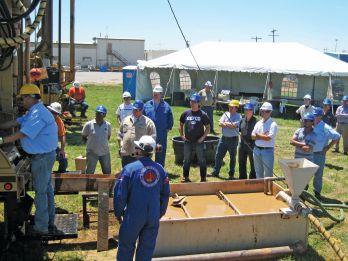
Alterra Power recently announced the completion of a joint venture agreement with Energy Development Corporation (EDC) to fund Alterra’s Mariposa geothermal project in Chile, along with three geothermal concessions in Peru.
The agreement calls for EDC to earn 70 per cent interest by funding 100 per cent of the next $58.3 million in project expenditures at Mariposa, and $8 million in project expenditures on the Peruvian concessions.
Advancement of individual projects will occur under separate shareholder agreements, which will follow the commercial terms of the joint venture agreement. These agreements will be subject to final documentation and project evaluation by EDC, with the expectation of completion in later 2013.
Photo courtesy of GEFCO
polIcy papEr suggEsts puttIng a prIcE on grounD watEr
Environmental writer Ed Struzik told international experts to better monitor and map ground water with help from the government, taxes, as well as put a more realistic price on water.
Mapping tells us where ground water is, how it moves and how it is replenished over time. Monitoring tells us how much ground water we have, what its quality is, and how the quantity and quality are changing. But mapping and monitoring water far below the earth’s surface is not easy or cheap.
“There are technologies for making ground water visible and options for internalizing costs. We need to embrace these tools,” Struzik said in his paper and presentation, Underground Intelligence: The need to map, monitor and manage Canada’s groundwater resources in an era of drought and climate change. “If we continue to treat ground water with a lack of respect, we do so at our peril.”
The frequency and intensity of droughts since the 1990s and effects of climate change make it all the more important to treat ground water more seriously, he noted.
“We already face ground water problems, and they will likely get worse as agricultural activities intensify, as demands on water from cities and industry, mining and energy developments grow, as pollutants migrate from historical and current sources into ground water and as the impacts of climate change alter precipitation patterns and the storage of water in glaciers, snowpack and reservoirs.”
Struzik’s presentation took place at a daylong session hosted by the University of Toronto’s Munk School of Global Affairs Program on Water Issues. His presentation was webcast and the session included panel discussions and questions by participating experts, as well as the live and Internet audience.
The event included a presentation of NASA photos showing
Continued on page 9

AroUND Th E worlD
Here’s a look at what’s happening around the globe:
pennsylvania: Elevated levels of methane, ethane, and propane gases were found in 82 per cent of the samples taken in the Marcellus shale due to fracking, according to a new study based on the analysis of 141 drinking wells.
India: Public utility authorities are planning to implement new technologies to improve the water supply, but according to a study by urban water policy consultant Deya Roy, it will not address the lack of access to water for the poor.
Israel/chicago: The University of Chicago and Israel’s Ben-Gurion University of the Negev will begin funding a series of research projects aimed to create nanotechnologies that address water shortages in arid climates. germany: At a conference, water scientists warned that the majority of the world’s population will be dealing with water shortages within two generations due to overuse, overpopulation and climate change.
japan: The country’s nuclear watchdog is warning that highly contaminated radioactive water may be seeping from the nuclear power plant into the ground water, and then into the Pacific Ocean.
PETITI oN DEMANDS N E STlé r E DU cE PUMPIN g
More than 140,000 consumers in Canada, and across the globe, are joining with the global corporate watchdog, SumOfUs.org, demanding that Nestlé cut back on water pumping during drought conditions for their operations in Aberfoyle, Ont.
Nestlé recently renewed its permit until 2017 to take about 1.1 million litres of water per day from Hillsburgh, Ont. The surrounding communities that rely on the aquifer have bylaws to restrict access to their own water during dry conditions in the summer.
Maude Barlow, the Council of Canadians and Ecojustice are also fighting back against Nestlé and the Ontario government office that handed out its permit.
“Nestlé’s appetite to commodify water and natural remedies is a recurring strategy by a corporation with a pattern of seeking to privatize and profit from traditional knowledge and our natural resources,” explained Angus Wong, Canadian campaigner for SumOfUs.org. “Nestlé’s chairman and former CEO once infamously declared that ‘access to water should not be a public right,’ and now his company is putting into practice its belief that every resource should be commodified and sold off. Nestlé is sucking up water from a Canadian watershed during drought conditions – to bottle and sell it off.” For more information on the petition, visit www.sumofus.org.
Great excavations
The
C448 applies to new and retrofit installations for ground-source pumps.
by Muktha Tumkur, P.Eng
In support of the Ontario’s provincial government’s long-term plan to use more renewable energy and eventually close d own dirty coal plants, geothermal systems provide an excellent source of green heating and cooling in a variety of applications, including residential, commercial, agricultural and industrial applications. Geothermal heating and cooling leverages underground temperatures to heat and cool buildings.
The work plan must include measures to prevent an adverse effect if hazardous gas is encountered while constructing, altering, extending or replacing the system.
As of May 18, 2012, the Ontario’s Ministry of the Environment (MOE) introduced Ontario Regulation 98/12 to improve public safety and protect the environment by strengthening the regulation of vertical closed loop drilling for geothermal energy systems. Regulation 98/12 requires geothermal installers to obtain an Environmental Compliance Approval (ECA) for vertical closed loop geothermal systems. Applicants are required to submit a work plan prepared by a licen sed engin eering practitioner or a professional geoscientist. The work plan must include measures to prevent an adverse effect if hazardous gas is encountered while constructing, altering, extending or replacing the system.
Very shortly after the regulation was introduced, engineers with the Ontario Geothermal Association (OGA) met with assistant deputy ministers and senior staff members at the Ministry to offer its expertise and assistance and to start the ECA process. Furthermore OGA engineers and their a ssociation p artners a cross C anada ( with assistance from Golder Associates) prepared

and submitted applications to the MOE for an ECA to perform geothermal drilling in Ontario. These applications include mandatory work plans that address the requirements of regulation 98/12 and other instructions that were issued by the MOE.
The intent of the new regulation and i nstructions i s t o d evelop m easures a nd procedures to protect against the release of hazardous gases such as natural gas and hydrogen sulphide while drilling boreholes and installing the grout and U-loops.
Some of the key requirements of 98/12 and the instructions include:
• Preparation of a Work Plan by a licensed professional engineer or geoscientist and
• equipment and procedures for monitoring hazardous gases during geothermal drilling
• A preliminary site assessment and step-by-step description of all the drilling activities
• Measures and procedures to be taken to control the release of hazardous gases during drilling and, if required, to kill the borehole (for example, to prevent the release of the gases)
• T raining o f d rilling c rews i n t he safe management of hazardous gases during drilling
• Notification to specified individuals if hazardous gas is encountered in a geothermal borehole
• Preparation of a Mitigation Completion Report by a licensed professional engineer or geoscientist if hazardous gas is encountered in a geothermal borehole.
The Ministry is also requiring installers to notify the landowner, occupant of the building, municipality, fire department and
the ministry’s Spills Action Centre if they encounter hazardous natural gas during installation of a closed loop vertical geothermal system.
Geothermal stakeholders and their senior geoscientist advisor met with M OE staff to review their proposed Work Plans. Several concerns were raised by the MOE technical reviewers leading to field tests, observed by MOE personnel that formed the basis for acceptable procedures.
Procedures acceptable to the MOE have been established and has led to a sample Work Plan template that is available on the OGA website (www.ontariogeothermal. ca) for reference by other geothermal drillers in Ontario. Each drilling company is responsible for preparation and submission of their own ECA Application including a Work Plan that is suitable for their equipment and procedures. Each ECA Application is posted for 45 days to allow public comment.
These procedures have led to guidance and requirements that are now contained within the CSA Group standard, CSAC448-2013 Design and Installation of Earth Energy Systems, that will now provide more guidance for drillers. The C448 applies to new and retrofit installations and also covers minimum requirements for ground-source heat pumps for residential and commercial buildings.
The C448 standard is developed and approved by technical subcommittees and a technical committee respectively that represents a multi-stakeholder forum representing the geothermal industry from across Canada. As an accredited standards developer in Canada and the U.S., CSA standards are developed using a consensus based, balanced matrix approach that ensures that concerns from all stakeholders are discussed and vetted.
The CSA C448 will be developed as a bi-national standard with the U.S. by 2015 as an ANSI designated standard. CSA Group is a not-for-profit, independent standards developer.
Muktha Tumkur, P.Eng., is the program manager of renewable energy for the CSA Group. She can be reached at muktha.tumkur@csagroup.org.
Continued from page 7
changes in ground water levels across North America. In his paper and presentation, Struzik noted that better mapping and monitoring — which can assist in better management — are possible thanks to these kinds of advances in research and technology.
“Ground water mapping and modelling can help farmers, industry, municipalities, and even managers of natural areas, plan on how much ground water can be pumped from an aquifer without running it dry. Mapping and modelling can help scientists predict how ground water will respond to stresses such as over-pumping, seawater intrusion, urbanization, drought and climate change,” said Struzik.
The solutions are costly and will require more

intergovernmental co-operation and new financing, including taxes in some cases, Struzik added. At the same time, better mapping, monitoring and management are possible, and critically important, because up to one-third of Canadians depend on ground water.
Struzik made 10 recommendations, including putting a more realistic price on water use for Canadians.
“Water is one of Canada’s most important natural assets, one that contributes between $7.8 and $22.9 billion to the economy each year. It’s time for more jurisdictions to start putting a price on ground water and on surface water,” he said.
GeoTherm al Ins I der
Geosource energy ceo stanley reitsma.
after close to a decade of serving the southern ontario region, Geosource energy has been on the front lines of the geothermal industry, we caught up with ceo and co-owner stan reitsma to discuss the industry, and ontario regulation 98/12.
by JulIE F ITz-G E RAld
GeoSource Energy is owned by three brothers: George, Stanley and Peter (missing) Reitsma.
how has the industry evolved over the past decade?
The type of work that is happening has changed an awful lot. From 2004 to 2006, it was almost all residential with these geothermal grants to retrofit the houses, but commercially there was very little. That’s now changed...The business has transitioned and I think really commercially and privately, for private business, it’s matured an awful lot in the past 10 years. While it’s not mainstream yet, it’s starting to become that way. In fact, we’re seeing it with condos now in Burlington and Hamilton. The Burlington, Hamilton and Milton area is a real hotspot for geothermal condo buildings.
as people become more aware of geothermal, are you seeing your customer base steadily growing?
I would say the developers that have gone with geo on one building have always continued. I have not seen anybody come away from it; once they’ve done it, they keep doing it and that would suggest to me that they like it, it’s selling, it’s working for their sales and once they understand how it works, they’re happy with it. A lot of our job is education and we’ll continue to do that until we hit a five per cent market share. Then customers will be aware of it.
how has technology evolved over the same time period?
The drill rigs and drill bits – we see sonic rigs now and drill rotary machines – all these


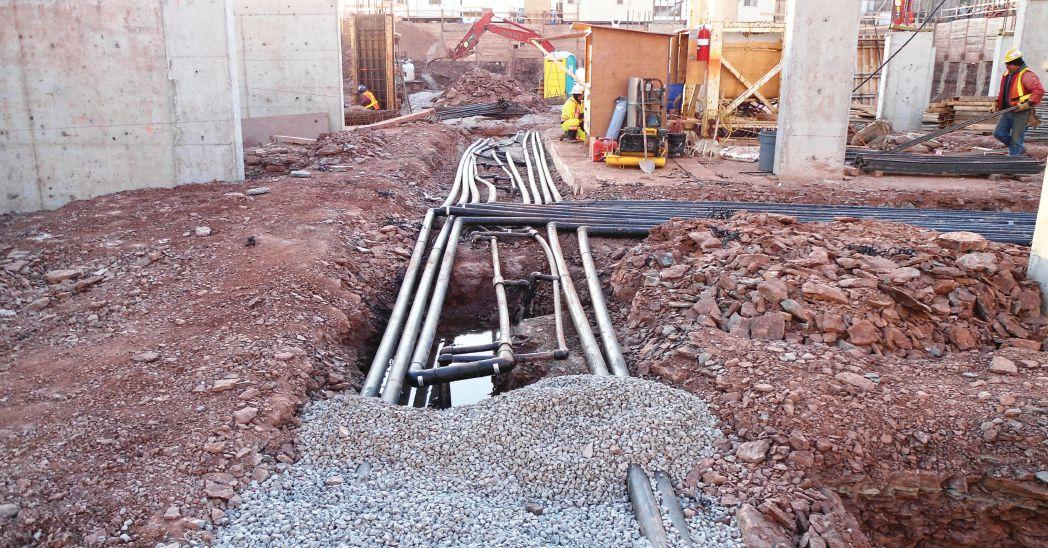
machines can get a casing in the ground quickly and pull it back out quickly. That technology has changed around in 10 years like you wouldn’t believe. There really wasn’t a geothermal drill rig available; it was all truck-mounted rigs. Now everything that we’re using is tracked, especially in commercial work. We’ve gone from six-inch or 4-3/4 inch holes down to 3-7/8 inch holes just to reduce all the costs associated with drilling and grouting. The dollar number per foot has gone down a lot, and that’s partly because the technology’s better. When we started if we could do 200 to 300 feet a day we were ecstatic. Now we can average 1,500 to 1,600 feet a day. We’re now looping and grounding three 600-foot holes a day, type thing. So the pricing’s coming down because the production has gone up, but in a way it’s making it more affordable for the geothermal systems to go in. The economics are there, there’s no doubt.
The other thing we’ve seen in development is the concept of what they call a utility, where someone comes in and opens a loop field and gets revenue from the building for, say, a 30-year period. That concept started to develop in 2006 and 2007. Now it’s becoming commonplace. A lot of developers will use their construction financing to put the loop or geo field in and they use some sort of take-up financing afterward
and they continue to own the loops. The condo then pays a yearly or monthly fee to them for the investment. The fact that there’s financing available for these systems will really start boosting the industry to date most geo systems are essentially out-of-pocket cash, which makes them tough to move forward. The banks have not been particularly interested in funding geothermal systems for big buildings, but as the industry matures that will also start to change.
how do you stay on the leading edge of new technologies in the industry? We tend not to watch the industry and follow the leader; we try to be the leader, at least in our business. For example, the PDC bit in 2006, nobody was using them; now they’re ubiquitous, they’re everywhere. We demonstrated it at a ground water demo in 2007 and people were wondering how we were drilling so fast. We were competing with a hammer-drilling guy and we were drilling twice as fast.
Another example is how we apply our drilling to the full construction approach. We do a lot of our geothermal loop fields under buildings prior to construction and we needed to figure out a way to drill from surface prior to excavation. So we pioneered a technique where we drill from surface, bury our loops down 20 feet below grade so the
tops of the loops are down, so when they go to excavate they don’t hit anything. Then we come back after they’ve gone to subgrade and we find our loops again, dig up the pipe, attach them, hook them up and bring them into the mechanical room at that point. We’ve done about 20 projects like that now, anywhere between 30 and 80 bore holes. That’s a niche for us.
what effect did ontario regulation 98/12 have on the industry?
As an industry stakeholder of the Ontario Geothermal Association, I was invited to sit in on the meetings with people from Queen’s Park and the MOE. When the details came out for Reg. 98/12 there were things in there like 50 feet of casing into the rock cemented in on every bore hole. We figured it would double the cost of geothermal bore holes and loops. As soon as I saw that, I thought that’s it, the industry is finished. I was distraught. We could not get them to move off of that casing... Eventually we came up with the idea of a bridge plug, which is basically a big rubber donut with steel grippers. You send it down the hole with the hydraulic setting tool that you put water pressure on from your drill rig and it basically pulls on this and forces it to widen out and squeeze into the hole. We proposed that to the MOE and that seemed to satisfy them.
The tie-in of geothermal boreholes at Ironstone Condominium in Burlington, Ont.
Every geothermal driller in Ontario now has to have a bridge plug setting tool in case of an unbelievable situation. They also insist now that the casing is grouted into the rock with bentonite to prevent gas migration up around the casing. For us that turned out to be a godsend because we discovered that we could get our casing out easier after... It was a fortuitous benefit of the reg. From my end, and this is not the same sentiment that everyone has, but I think the regulation needed to happen, it was just too bad that it happened in this manner. It was a reaction as opposed to being proactive. It was so brutal and abrupt that it raised an awful lot of anger, mistrust and fighting because of it.
how did the federal government’s end to the ecoEnergy retrofit program affect the industry?
It’s something that a lot of people would like to see come back, certainly for the heat pump guys, but for the drilling industry, the reality is that it’s the commercial side that has the big projects happening and they are unaffected by grants. There are virtually no grants for those; there never were.
are there any exciting future plans for geosource Energy that readers can watch for?

GeoSource on the job at a geothermal project in Milton, Ont.
are surprisingly large and they’ll pay for the drilling. You can easily save a million dollars inside of a $30-million building and then that money can be used on the drilling side, for example.
This interview has been edited and condensed.
Julie Fitz-Gerald is a freelance writer based in uxbridge, Ont., and is a regular contributor to Ground Water Canada
We have some new drilling technology that we’re working on. We don’t know how it’s going to turn out so I can’t give
Beauregard_7x3.25 3/21/06 7:45 AM Page 1
too much detail on it yet. We’re also developing a new grout that we’d like to bring out. We’re working with some people to do this and we’re hoping that it turns into something. That should roll out in the next six months or so. Another thing that we’re really working towards in our business is getting more involved with the buildings and trying to push technology forwards, so things like an integrated pipe system that uses the hot/cold water distribution in a building to bring the heat and cool around the building...So you save money on the HVAC side and those numbers


Chili and your intuition
By Jeff Mowatt
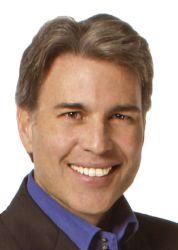
8 ingredients for making better strategic decisions.
As a business owner or manager, what you ultimately rely on most when deciding your company’s future, is your intuition. Effective leaders hone their intuition the way a chef cooks a pot of chili. Like chili, intuition needs to include the right ingredients and then be allowed to simmer a while. Here are eight ingredients for you to stew on.
1. get customer coaching
Even as a senior executive, you’ll end up making better decisions after spending some time at the front line talking directly with customers. Ask them the key question, “What can we do to improve our service?”
2. listen to those in the know
It’s an understatement to point out that Sam Walton had good business instincts. Wal-Mart’s founder said, “Listen to everyone in your company, especially the ones who actually talk to customers. They really know what’s going on out there.” ’Nuff said.
3. ask your competitors – really
I’m not just referring to visiting your competitor’s store. If you are in a service industry there may not be a store per se to visit. One of the best ways to learn from the competition is to join your professional trade association. I’ve always found that when it comes to joining a professional association, the more you get involved and contribute to the group, the more you ultimately receive.
4. read by listening
Business books are filled with great ideas, providing you actually read them. As a time saver, consider buying your books on audio so you can listen while driving. I subscribe to a service that sends me summarized audio recordings of two business books each month.
5. get some seminar smarts
Some folks seem to think that once they complete their formal schooling, there is no need to continue with their education. That’s like exercising in college
and then figuring we can sit on the couch for the rest of our lives. Learning isn’t an event; it’s a lifelong endeavour. Make a practice of attending seminars and training sessions. A bonus of learning with others is that you have the opportunity to exchange ideas, network, and – provided you have a skilled facilitator – end up having some fun and stress relief.
6. learn the unwritten rules
You may have a wonderful new idea for your company, but if it clashes with the culture, you’ll soon face resistance and subversion. Savvy individuals learn where the company has come from so that they can reinforce and uphold closely held values as they introduce change.
7. clariFy your code
We all read the headlines of high-profile managers facing criminal charges. Apparently, their primary moral code is maximizing short-term profits at all costs. Increasingly, individual managers are being held personally accountable by shareholders, government regulators and consumers for their ethics. When making strategic decisions, ask yourself, “Is this the right way to conduct our business?”
8. g et smarter by going slower
When it comes to honing your intuition, keep in mind one of the great myths in business is that you need to fill every waking moment with activity. After attending a presentation by Patricia Katz on “Permission to Pause” it occurred to me that those individuals, particularly managers, who slow down and reflect are often the most creative, adaptive, and, ironically, productive. When you take all these ingredients, mix ’em up, and chew on ’em a while, chances are you’ll end up making wiser decisions for your organization.
This article is based on the critically acclaimed book Becoming a Service Icon in 90 Minutes a Month, by customer service strategist and professional speaker Jeff Mowatt. To obtain your own copy of his book or to inquire about engaging Jeff for your team, visit www.jeffmowatt.com or call 1.800. JMowatt (566.9288).

INDUSTRY NEWS
SolINST To h oST F oU rTh-ANNUAl SyMP oSIUM

Solinst is hosting a symposium on the benefits and importance of high resolution, depth-discrete ground water monitoring on Nov. 7.
The fourth annual event, held in Georgetown, Ont., offers a new one-day format. It will feature the following speaker line-up:
Dr. gary wealthall, geosyntec consultants: History of the Evolution of High Resolution Tools and Methods for Groundwater Monitoring
Dr. patryk Quinn, university of guelph: Hydraulic
Testing in Fractured Sedimentary Rock for Contaminant Hydrogeology Studies
Dr. richard amos, university of waterloo: Diavik Waste-Rock Research Project, High Resolution Gas Pressure and Concentration Monitoring
Dr. Kent novakowski, Queens university: Developing Conceptual Models for Flow and Transport in Bedrock Aquifers Using Depth-Discrete Hydraulic and Tracer Transport Measurements
Dr. jessica meyer, university of guelph: A High Resolution Vertical Gradient Profile Approach for Delineation of Hydrogeologic Units at a Contaminated Fractured Sedimentary Rock Field Site
A round table discussion, moderated by Gary Wealthall, will be held at the close of the symposium. It will encourage open discussion with all attendees and the panel of speakers participating in the discussion. The roundtable will allow attendees to discuss highresolution tools, methodologies, applications and benefits.
Registration forms and full agenda can be found on the Solinst website (www.solinst.com) or call to register at 905-873-2255.
B & H Construction, LLC of Goldsby, Oklahoma, relies on the productivity
durability of the GEFCO 30K for the fastest completion of water well and geothermal drilling in the industry.
INDUSTRY NEWS
g run D fos
I ntro D uc E s magna 3
The MAGNA3 is a variablespeed wet rotor circulator that cuts power consumption by up to 85 per cent compared to conventional circulators.
It offers the ability to match pump speed to varying system loads. It is also designed with variable-speed with an electronically commutated motor (ECM)-based circulator that uses an integrated logic algorithm to “learn” the varying energyusage patterns of an application over time. This is built to enable the software to automatically determine the lowest possible operating-efficiency point.
The auto adapt function continuously updates power consumption and flow rates.
“As demand for water
efficiency surges, building operators are zeroing in on the untapped potential of smart pumps,” said Simon Feddema , president of Grundfos Canada, in a news release. “MAGNA3 is the only circulator on the market which lives up to their demands for efficiency, intelligence and sustainability.”
The MAGNA3 consumes 20 to 40 per cent less energy than most models in the current MAGNA line. In developing the MAGNA3, Grundfos committed to achieving the European Energy Efficiency Index of 0.20, which exceeds the efficiency ratings of any circulators on the market in North America.
The product features building management systems and built-in heat energy metering. Additionally, wireless connectivity enables handheld
pump control, monitoring and reporting capabilities by Grundfos GO, a mobile toolbox available on Apple and Android devices.
In addition, MAGNA3 now handles temperatures as low as 14 degrees Fahrenheit, making it an even better choice for cooling as well as heating applications. It also features a near 60 feet and the maximum flow to approximately 570 gallons per minute.
And with more than 35 single and twin circulators in either cast iron or stainless steel, MAGNA3 is the solution for a wide range of commercial and domestic applications: heating, cooling and airconditioning, domestic hot water, ground source heat pump, and solar heating.

FrusTr aTI ons
w ITh F ra C k I n G
this chart sheds light on hydraulic fracturing.
not too many environmental stewards are rooting for hydraulic fracturing, or fracking, as it’s known, in canada. this controversial drilling process is used to extract natural gas from shale, and coal beds with horizontal and vertical drilling.
When Environics polled Canadians across the country, roughly 62 per cent said they strongly or somewhat supported a moratorium on hydraulic fracturing for natural gas until all federal environmental reviews have been completed. By region the biggest supporters of a moratorium are: British Columbia (67 per cent), the Atlantic provinces (66 per cent) and Ontario (65 per cent). The weakest support comes from Saskatchewan/Manitoba (64 per cent), Alberta (57 per cent) and Quebec (55 per cent).
Concerns arise because of the large quantity of water needed, along with thousands of chemicals that are injected into the rock bed at a very high pressure to free up the trapped gas. The chemical-filled water has the potential to seep into the cracks created during the process, and end up contaminating the ground water.
Emma Lui, the water campaigner for Council of Canadians, says that the organization opposes fracking for a number of reasons.
“We stand against it as it can initiate water contamination,” she explains. “Some other implications are the large amounts of waste water, which there are no regulations of how to properly dispose of, as well as the large amount of water used in the first place.”
Communities across the country are raising red flags because of water contamination, greenhouse gas emissions
and the impacts on public health.
One woman in Rosebud, Alta., is suing Encana after her water well became contaminated with chemicals to the point where her dogs wouldn’t touch it. The lawsuit was launched last year.
Jessica Ernst is a scientist with 30 years’ experience in the oil and gas industry as a consultant. In June, she released a 93-page report on her findings on the process.
She states in her report that “obtaining data on ground water contamination caused by the oil and gas industry in Canada is nearly impossible because of confidentiality agreements (non-disclosure or gag orders). This should be made illegal.”
On the other hand, Ken Hugo, a hydrogeologist, says that oil companies have a high incentive to avoid polluting ground water with chemicals.
“They don’t want to screw up otherwise they will lose their investment, and they don’t want that,” stresses Hugo, who is also the technical director for the Alberta Water Well Drilling Association. “If you frack into a water zone then it’s more likely to go into your gas zone, than the gas will go into the water zone. Once the water is in your gas zone, then your well is kaput.”
He adds that many areas have levels of naturally occurring methane, and other chemicals. After several studies were completed, it was found that most of the contamination was caused by poor maintenance of the well bores.
by KAR ly O’B R IE n
Is this process as bad as everyone thinks, and how much fracking is happening in Canada? Here is a chart outlining where fracking is currently or might be occurring, and has already taken place. It also mentions where “fraccidents” (fracking + accidents) have occurred.
Please note:
• In Quebec, an American company, Lone Pine Resources, is planning to sue the Canadian government, under the provisions of NAFTA, for more than $250 million over Quebec’s moratorium on hydraulic fracturing. The province enforced a moratorium temporarily to conduct environmental research on the fracking process.
• In Prince Edward Island, no fracturing is currently happening since the government stated that no hydraulic fracturing would happen unless there were environmental assessments and public consultations first.
• In the Niagara region of Ontario, a resolution calling for a provincial moratorium on fracking was passed. No fracturing has occurred in Ontario, but companies are busy buying up land.
See chart on page 20
Laser Marked Water Level Meter

The 101 P7 Water Level Meter uses Solinst laser marked flat tape, which is accurately marked each mm or every 1/100 ft and Certified Traceable to National Standards. New submersible P7 Probe ideal for total well depth measurements to 300 m (1000 ft). Standard Model 101 P2 Water Level Meter with heat embossed markings still available.
• Durable, non-stretch PVDF flat tape
• Accurately marked each mm or every 1/100 ft
• Certified Traceable to National Standards
• Tape splice option maintained Laser Marked Flat Tape
Drill Smarter
Drill faster, cheaper, smarter with Sonic Drill Corporation’s award-winning, patented drilling technology. Put it to work on your next project to heat up profits and cool down costs. It’s the perfect choice for geothermal installations, environmental investigations and mineral explorations.
• Drill 3-5X faster (depending on conditions).
• Drill, case, loop and grout in one step for geothermal projects.
• Collect continuous, undisturbed core samples to 300 ft.
• Drill using water or air (depending on conditions).
• Produce up to 70% less mess, lower your site clean-up costs.
• Various rig sizes (some fit in a 20’ shipping container to drastically reduce shipping costs).
REGULATIONS
Potential areas of fracking Active fracking‘Fraccidents’
Potential fraccidents
b ritish c olumbia
a lberta
s askatchewan
m anitoba
Liard-Besa River, Fernie, Nordegg, Duvernay
Muskwa, Blood Reserve, Hamburg Lands
o ntario
Horn River, Montney, Greater Sierra, Klappan
Fort McMurray, Suffield, Eagle Hill, Devonian Duvernay, Beiseker, Innisfail
Waskada
Lake Erie, Lambton County, Chatham-Kent, Collingwood/Blue Mountain, Kettle Point Formation
Quebec
n ew b runswick
n ova s cotia
n ewfoundland and l abrador
p r ince
Stoney Creek, Cocagne, Marysville, Penobsquis, Salisbury
Raymore, Duval, Penzance, Simpson, Belle Plain, Last, Mountain Lake
Sally’s
e dward i sland Eastern P.E.I.
n orthwest
terr itories
sources
1. http://nbfrackingresearch.com/
Wetaskiwin, Red Deer, Innisfail
Drumheller
Moratorium and projects on hold
Potential moratoriumFracking ban
Previous fracking locations Disputed fraccidents
Wascana
Bakken, Rocanville, Viewfield, Ceylon, Hummingbird, Roncott
Niagara-onthe-lake
Lorraine/Utica Lands
The province
Utica shale formation, project #1, Utica shale formation, project #2, Utica shale formation, project #3
2. www.swn.com/operations/PublishingImages/nb-big.png
3. www.ernstversusencana.ca/wp-content/uploads/2010/10/Statement-of-Claim.pdf
4. http://business.financialpost.com/2012/11/07/alberta-has-huge-shale-oil-gas-resources-study/?__lsa=152d-0311
5. www.ffwdweekly.com/article/news-views/news/citizen-encana/
6. www.ernstversusencana.ca/wp-content/uploads/2012/12/2011-03-02-ERCB-unconventional-gas-report-2011-A.pdf
7. www.encana.com/communities/canada/ 8.www.frackingcanada.ca/fracking-calgary/
9. www.cbc.ca/news/canada/new-brunswick/story/2013/06/21/nb-alward-first-nations-shale-gas-1002.html
10. http://canadians.org/media/water/2012/06-Feb-12-backgrounder.html#.UdMFieuG7bk
11. www.facebook.com/SaveGrosMorne
12. www.savegrosmorne.ca
13. www.mountainviewgazette.ca/article/20110913/MVG0801/309139989/0/mvg 14.www.albertatechfutures.ca/NewsRoom/MediaCoverage/PromisingDuvernayformation.aspx
15. www.cbc.ca/news/canada/north/story/2013/06/12/north-sahtu-fracking-decision-reaction.html
16. www.huffingtonpost.ca/2012/11/23/quebec-fracking-ban-lawsuit-lone-pine_n_2176990.html
G rou nd water canada | FALL 2013
Burnaby Cutbank Ridge
Rosebud,
Volcana Volcana, Ponoka, Eagle Hill
Lorraine/Utica Lands
Kent County
McCully Field Penobsquis
The province, Elmworth
Cumberland County, Inverness Lake Ainslie
Cove, Shoal Point, Lark Harbour, Green Point, Port Au Port Peninsula Bay St. George Basin
The province
Norman Wells
“Cotey

Eddie G. - West Texas Farmer
w ords o F waTer w I sdom
a Q&a with robert (bob) sandford.
bob s andford can carry on one fascinating conversation about water. h e is the author of five books on the subject, with a sixth slated for publication in o ctober.
by JulIE F ITz-G E RAld
Bob Sandford is the author of five books on water, and the EPCOR chair of the Canadian Partnership Initiative in support of the united nations’ Water for life decade.
Sandford is also the EPCOR chair of the Canadian Partnership Initiative in support of the United Nations’ Water for Life Decade, sits on the advisory board of Living Lakes Canada, and is a member of the Forum for Leadership on Water (FLOW). This Canmore, Alta., resident spent time on the telephone with Ground Water Canada to discuss the changing hydrological cycle and how it will affect Canadians and water well drillers.
Bob, have you always been intrigued by water or did something in your life spark this passion?
The first backpacking trip that I ever did was over the Columbia ice field when I was 20. The accident happened while we were descending the Saskatchewan glacier on the second day. I was so tired I’d given up trying to avoid the
big melt water streams that course across the glaciers surface. Seeking to take a direct line, I trekked across one of these and of course the water picked me up and carried me to the mouth of a huge crevasse. One moment I was looking in the splashing water and the next I was in the centre of a waterfall plunging into complete darkness beneath the ice. I have to say that never before or since have I ever heard from everywhere around me so many of the different sounds that water makes. There was only a few inches that separated the top of the water and the roof of the ice and in the darkness. I kept scraping against the underside of the glacier, but just as shock and wonder were beginning to evaporate, just as calm was about to become sheer terror the strangest thing happened. The ice above me began to glow. At first it was a faint green and as the
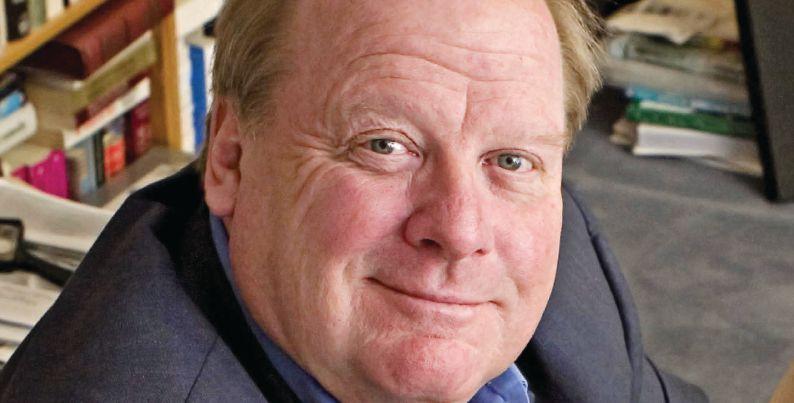


river swept onward the glow intensified and gradually green merged into a pale blue and then I noticed that rocks were hanging out of the ceiling made entirely of light. Then I was washed out of the glacier into the full flood of the Saskatchewan River. So that was my initial inspiration to work with ice and water; that’s why I continue to work on glaciers and continue to be reminded of how the hydrological cycle works and what a wonder it is.
what has it been like to be involved in the canadian partnership Initiative for the un’s water for life Decade?
The first and most important thing I must tell you is that it has been an honour and a great privilege to work with some of the very best water scientists in this country. It’s through them and by way of their co-operation and sharing that I have been granted information and perspectives that have allowed our initiative to have some success and it’s because of their commitment, their sharing, taking the time to teach me what I need to know about these often complicated water matters that has been the foundation of my work. Our goals are really threefold. We want to dispel the myth of limitless abundance of water in Canada. We want to translate scientific research outcomes into language the average Canadian can understand and that decision-makers can use to craft timely, endurable public policy and the third thing that we want to do is to bring international example to bear on Canadian water issues. So those are the three goals.
with respect to the flooding that’s been taking place in various canadian cities, is this something that we should expect to see more of?
This is one of the most important questions we should be asking in this country right now. The flooding in Calgary, Ontario and Manitoba should be viewed collectively as a 911 for every level of government in Canada and when supposed experts tell you not to worry because the earth has experienced higher concentrations of carbon dioxide and warmer temperatures in the past, what they don’t tell you is that during those epochs, extreme weather events lasted for days and even weeks. We’re
discovering evidence that increasing temperatures are accelerating the manner and rate at which water is moving through the global hydrological cycle. The evidence is now widely enough available for us to begin to connect the dots with respect to Canada’s changing hydro-climatic conditions.
This is the point I really want to make: warming is causing the post glacial hydrological wealth of Canada to move to a different place in the hydrosphere and this is VERY interesting because we see clear evidence of this in Canada’s western mountains where I live and in the domain which we have been examining glaciers for some time. We now know that we’ve probably lost as many as 300 glaciers in the Canadian Rockies in the last 85 years and we have good evidence that this is probably accelerating. The snowpack and snow cover patterns are changing and then you begin to look at what else is happening. This Lake Huron thing is really problematic for us as well. It’s the second largest of the Great Lakes, a landscape relic left behind from the last major glaciations. Based on September averages, water levels of Lake Huron have declined by 115 centimetres between 1997 and 2012. Some say that it’s the dredging of the St. Clair River outlet that plays a role, but we’ve also noted that these declines in water level are also related to a decline in the amount of precipitation falling as snow as opposed to rain in winter and also a decline in the extent and period during which the lake is frozen during winter and a trend toward greater evaporation brought about by higher atmospheric temperatures. So the same warming that’s causing the Arctic to change is also causing water in the Great Lakes region to move to a different place in the hydrological cycle. Research suggests that as much as 67 cubic kilometres of water may have disappeared from that part of the Great Lakes system since 1997.
so where is all this water going?
Well, one of the places that it’s going is into the atmosphere where it becomes available to fuel more frequent and intense extreme weather events. It’s becoming very clear that rising temperatures and the increasing concentration of atmospheric vapor
are making what once were predictable natural events a lot worse. The algorithm upon which this assertion rests is called the Clausius-Clapeyron relation. It’s one of the basic tenets of atmospheric science and establishes that the amount of water the atmosphere can hold increases by about seven per cent per degree Celsius. We know now that Canada is 12 per cent wetter on average than it was in the 1950s and more severe weather events are already a reality. We’re seeing stuff out there that is just staggering, things like atmospheric rivers that we can see with satellite imagery, these huge volumes of water vapour aloft that can deliver between seven and 15 times the annual flow of the Mississippi upon contact with land or with cool funnel systems. So the big deal here is that our hydrology is changing and the hydrological cycle is becoming more energized and that is one of the elements contributing to increased flooding.
what kind of an effect will flooding have on canadians in general and on the water well drilling industry?
There really is potential in some of these circumstances for aquifers to be recharged, depending on where they are. Looking at the Great Plains, we’ve observed an increase in precipitation, but it’s not straightforward like you’d think. The pattern of rainfall is changing. Historically most rain came to an area from thunderstorms. A thunderstorm would rise up out of a hot prairie in the afternoon and maybe dump for a few hours and the water would improve soil moisture and recharge aquifers. What we’re seeing now is that the systems are more often frontal and last for days. They bring a lot more precipitation and they mobilize up to 10,000 times more E. coli from manure and farmers fields, so you’ve got two elements here that you’re going to have to be more cautious about with relation to contamination of wells. On the other hand, you may see some positive regeneration of or recharging of some aquifers. People who are on wells are going to have to be more cognizant that these longer-term events could produce situations where contamination is more possible, so diligence is definitely required.
Continued on page 29

PENTEK INTELLIDRIVE™

3 drives cover all your needs
Models up to 5HP, Three Phase
Models up to 2HP, Single Phase
- Up to 1-1/2HP, 2-wire applications
- Up to 2HP, 3-wire applications
For submersible or above ground well pumps
State of the Art Surge Protection
LCD Diagnostics
Ground Detection
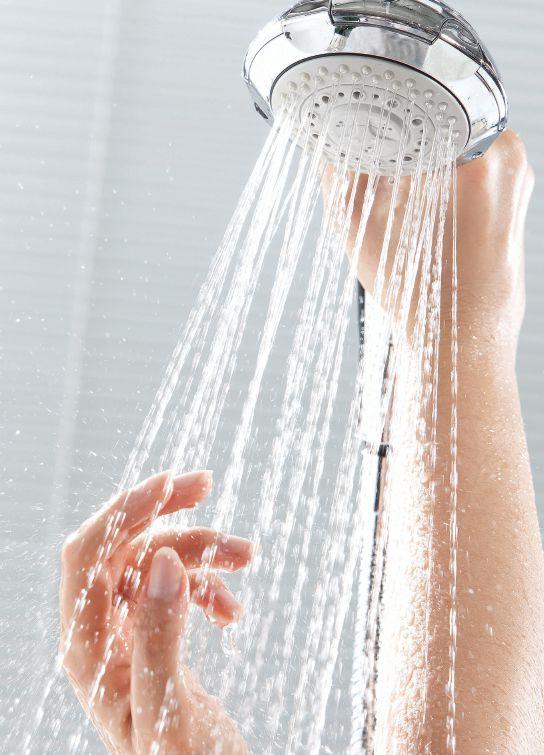
pro F ITs and pe TITI o ns
a look into how nestlé stirred up ground water sentiments.
bottled water is big business, and its use of ground water has recently caused quite a stir.
Global corporate watchdog SumofUs.org recently launched a petition against Nestlé Waters Canada’s water withdrawals during droughts at its operations in Aberfoyle, Ont. So far, the petition has reached about 142,500 signatures of support, which is 7,500 signatures short of the organization’s final goal.
Nestlé was given a permit this year good through to 2017 that allows the company to take 1.1 million litres of water per day from Hillsburgh, Ont. for its bottling plant in nearby Aberfoyle. Initially, the permit mandated that Nestlé reduce its water withdrawals by 10 to 20 per cent,
depending on drought severity. The company appealed these restrictions to the Ontario Environmental Review Tribunal, but Nestlé and the Ontario Ministry of the Environment reached an agreement before the tribunal came to a decision, and the two restrictions were removed in February.
“This is just another example where the government favours corporations versus public needs,” comments Kaytee Riek, campaign manager for SumofUs.org. “Then there’s Nestlé who is only motivated by profit, and that was evident when they said water wasn’t a human right, and tried

by KAR ly O’B R IE n
to patent a natural-occurring remedy.”
In early June, the Council of Canadians, along with several other regional conservation groups, appealed the ministry’s reversed decision to the same tribunal to finally find out their ruling on the issue.
People are beginning to realize the extent that companies are privatizing our water by getting permits, then putting it in a bottle and selling it, says Michael Nagy, the chair of the Wellington Water Watchers (WWW).
“In Ontario, at least, the permits were never meant to allow people to profit

off of selling the water,” he continues. “It was designed to keep an eye on how many straws we have in the glass for municipalities. On top of that, they target the deepest wells so it is the last one to see any issues.”
Nestlé’s previous permit didn’t include mandatory drought limits, which is why the company appealed the new permit’s restrictions. The public’s concern is with the three droughts that the area has experienced since 2007, with the first half of 2012 being the driest since 1958.
“This is interesting because drought levels refer to surface bodies such as lakes, rivers, and streams – not ground water,” states John Challinor, corporate affairs for the Guelph region of Nestlé Waters Canada. “There’s just simply no impact or causation between drawing water and droughts. That said, we would reduce our water anyway on a voluntary basis, not a mandatory one.”
Nestlé purchased Aberfoyle Springs in 2000, and the multinational corporation inherited four wells and two bottling plants: District of Hope, B.C. (primary and a backup well, and a plant); Erin, Ont. (one well); and Aberfoyle, Ont. (one well, and a plant).
The Canadian Bottled Water Association (CBWA) states the industry as a whole only accounts for a small portion of the country’s water withdrawals.
“Let’s put this situation into perspective,” says Elizabeth Griswold, executive director for CBWA. “The industry uses about 0.002 per cent of the
water used in Canada.” She goes on to say that equals the same amount of water that nine golf courses use for the summer, not including spring or fall.
Despite the small percentage, some Canadians argue that the bottling industry is going to negatively impact the ground water levels, and/or cause droughts and problems with nearby private wells.
“These [companies] are using the water as purely consumptive, with none of it going back into nature or the ground water,” says Nagy on the issue. “Whereas agriculture is value-added, and it is going back into the ground, where it came from.” However, some are skeptical of how much of the water used actually gets back into the water table.
David Siwicki, a hydrogeologist with SPL Beatty, says it’s difficult to pinpoint why water levels shift.
“You can’t blame any one industry for water problems, or droughts without a thorough research report conducted,” he says. “However, water taking is more likely a local issue than a regional or provincial issue as the nearby aquifers will be directly affected by what is happening locally.” He describes it as a cone of influence, and stresses that more studies need to be conducted to allow for a better understanding of any immediate and longterm effects.
Moving further west, British Columbia may start regulating its ground water and issuing (or denying) permits to any company or person who wants to withdraw large amounts of ground water.

If the act is passed, it will be implemented next year making B.C. the last province to regulate it.
These provisions are included in the recently revised century-old Water Sustainability Act (WSA). It states that a charge will be enforced, as well as regular testing that will make it more difficult for companies to take any amount of water they think is suitable.
Challinor said in the past Nestlé has voluntarily sent the B.C. government reports on its usage, but recently the company has stopped. The province does not currently charge Nestlé for taking any water that it uses for bottling.
The company reports that it drew 71 million gallons of water in 2012, and stated that it does its own mapping to ensure that this is a safe amount to take.
The proposed WSA was first introduced in December 2010 as part of the province’s Water Act modernization process, which was formally initiated in December 2009.
Joan Perry, office secretary for The British Columbia Ground Water Association (BCGWA), says it congratulates the movement towards regulation and supports increased monitoring on companies using the resource.
a closer look
So how do companies acquire permits, and what sort of testing do they need to do in order to get a passing grade? A permit to take water is regulated differently in each province and territory with variations in




costs, application processes, fees, and how it is monitored. Ground Water Canada took a look at how some provinces are handling the responsibility.
n ewFoundland and labrador
Tina Coffey, communications specialist for the Department of Environment and Conservation for Newfoundland and Labrador, provided information on how companies are permitted, and what guidelines they must follow within the province.
Coffey said that all companies are required to apply for a permit to take water under the Newfoundland and Labrador Water Resources Act (WRA). There is no threshold that exempts any company from purchasing a water-use permit, meaning it is mandatory for all amounts of water withdrawals. For ground water sources using wells, a permit for construction of a nondomestic well is also required under section 58 of the WRA.
The main stipulations for water withdrawal include: initial testing before a company can withdraw water; no infringement on quantity or quality of water sources; and annual reports. Other terms state non-exclusive water rights may be suspended, modified, or cancelled with a notice of 30 days, and the company is not permitted to sell bulk water or remove bulk water outside of the province.
Companies are required to pay a fee of $1,000 plus HST for a water-use licence, and $100 plus HST for building a non-domestic well. For bottling or beverage companies, the province requires the payment of applicable fees or royalties for the use of water.
In a chart Coffey provided to Ground Water Canada, there were five companies that draw from ground water resources, while the sixth uses a small stream originating from ground water: Garden Springs, George Yates, Main Brook Waterworks, McCurdy Enterprises, and Markland Cottage Winery, and St. Pierre Tours (not active).
n orthwest te rritories
The Ministry of the Environment regulates ground water resources in this province, but it does not monitor and issue permits. Instead these responsibilities fall under two nongovernmental agencies: Northwest Territories Water Board (NWTWB), and the Mackenzie Valley Land and Water Board (MVLWB).
These groups declare that if a company or person is withdrawing more than 100 cubic metres of water, then a type B permit is required. Anything more than 300 m3 is issued as a type A permit. To apply, renew or cancel a permit costs a total of $30. The charges to withdraw water are as follows: the first 2,000 m 3 is $1 for every 100 m 3 used per day every day. Any quantity that is greater than 2,000 m 3 is $1.50 per 100 m 3 per day every day, and for amounts greater than 4,000 m 3 it is $2 per 100 m 3 per day every day.
According to the agencies, there are currently no beverage operators with permits.
The industry is small, but it has people concerned of the effects locally, provincially, and nationally. There are no answers yet, just the need for more research into the issue.
are there any foreseeable issues that water well drillers in canada should be bracing for in the coming years?
I just wish to say that I’m deeply concerned about ground water in Canada. First of all, we have contaminated aquifers from coast to coast to coast in this country. We have widespread ground water problems and one of the things we’re trying to make very clear to governments is that it costs between 35 and 200 times more to remediate ground water contamination than it does to prevent it.
We need to do everything we can in this country to reduce the threat of ground water contamination because in 50 to 60 years from now when our population is much bigger and our reliance on ground water is greater, if we reach down there and we’ve contaminated these places, we will never be able to forgive ourselves. Now is the time to become very serious about ground water protection.
what needs to be done to help the situation?
First of all, we need accurate ongoing monitoring and also, accurate ongoing ground water mapping. We need to pay close, close attention to issues like fracking. We need to understand exactly what’s happening with increasingly complicated substances that we find in agricultural runoff, because we’re ending up with pharmaceuticals and stuff like this, so we need to pay very close attention. I’m not saying that’s a serious problem yet, but it’s certainly on our radar. We also have to start managing surface and ground water conjunctively. Surface and ground water is the same water and we keep managing ground water as if it’s separate. We need to have better integration and conjunctive management of both surface and groundwater. It’s going to require that municipalities and rural districts think carefully about that relationship and it’s also going to require new and more earnest ground water protection legislation provincially and federally.
what kind of role do you see water well drillers having?
I think water well drillers have a responsibility, because of their knowledge, to communicate as much as they can about the well situations that they’re creating and servicing. Also, I think it’s very important that well drillers help those they serve to understand how to properly maintain wells so that they can minimize the risk of contamination. Also, I would really like them to be able to communicate whether or not these areas are effectively mapped so that we can start putting pressure on governments to make sure that this mapping is adequate and ongoing. Just to sustain that passion they have for understanding and sharing information about water, that’s helpful to everybody.
This interview has been edited and condensed.
Julie Fitz-Gerald is a freelance writer based in uxbridge, Ont., and a regular contributor to Ground Water Canada.

AD INDEX
saving for retirement
by Simon Francis

How to better plan for your retirement when you don’t have the luxury of a guaranteed pension.
Small business owners don’t have the benefit of guaranteed pension plans to fund their retirement. When they reach the age of 60 they may find their peer group winding down, planning their winters and arranging to spend time with grandchildren. Meanwhile they will contemplate having to work much longer, some into their 80s, just to ensure financial stability.
The trend to delay retirement is correlated to current financial markets.
Business owners are coached by their advisors to take sufficient salary to maximize their RRSP contributions. Currently the earned income threshold to maximize RRSP contributions is approximately $132,000, which can leave minimal cash flow for other retirement planning. There are a few disadvantages associated with RRSPs, and these include the restriction on eligible investments that can be purchased in the plan as well as minimum withdrawals from the plan at age 72.
When considering investments, generally investors will want their portfolios to be more conservative in later years. Unfortunately the return on safe investments such as GICs, T-Bills, etc., is very low, resulting in a lower annual income stream on the principal investment. This means business owners will have to work longer to build their nest eggs.
The winds of change have blown in a new concept that utilizes a corporation to assist with retirement planning. The main benefit of this strategy is a tax deferral. Let’s assume a Canadian Controlled Private Corporation with taxable income of $500,000 taxed at favourable small business rates of 15.5 per cent. Also assume that a portion of the income is available for investment as it is not needed for day-to-day requirements. With the highest marginal personal tax rates at 46 per cent, approximately 30 per cent of tax is deferred by leaving money in the corporation.
Other benefits of using a corporation for
planning your retirement include the ability to income split with a spouse, if he or she is a shareholder with no other income can receive approximately $40,000 of tax-free dividends. A corporation also provides the opportunity to choose when funds are withdrawn from the corporation to pay for retirement expenses. This allows for funds to be withdrawn from the corporation during retirement years when personal tax rates are generally lower.
In addition to having more money to invest, there is increased flexibility with funds held in the corporation. For example, investments such as rental properties and shares in other private corporations are commonly purchased. These investments would not qualify as eligible investments in RRSPs. The benefits of these alternative investments are that they usually yield a higher annual return and can appreciate more over time.
The flexibility of a corporate retirement plan over a personal one includes the use of pension and other products that are not available as individuals. “Individual pension plans” (IPPs) and “retirement compensation arrangements” (RCAs) are plans that would otherwise not be available to an individual. The major benefit of these plans is that contributions to catch up to an arranged target return are a tax-deductible expense to the corporation.
If your business is your only source of income, then it’s time to think about how you can use it both to help you save for retirement and as a means to leave money for your family. The key is to plan and speak to your advisor about your options.
Simon Francis is an audit and assurance partner at Fuller landau llP, Chartered Accountants. His practice focuses on helping business ownermanagers achieve their growth plans. He can be reached at sfrancis@fullerlandau.com or by phone at 416-645-6583.

Sound Inve StM ent!
2013 Groundwater Expo A Sound Investment
3-6

DISCOVER SOLUTIONS
Explore the exhibit hall—
• Twelve hours over two days
• Hundreds of exhibitors
• Tens of thousands of square feet of exhibit space
• Scores of new products, services, and technologies.
IMPROVE YOUR BOTTOM LINE
Learn what’s new and earn your CEPs during workshops such as—
• Components and Benefits of Properly Constructed Wells
• Geothermal Vaults
• Misuse of Chlorine in Wells and Pipelines— Is More Really Better?
• Protecting and Preserving the Private Well Option
• Submersible and Jet Pump Troubleshooting
• Understanding Health Care Reform: What Employers Need to Know
• Vehicle Inspections and Maintenance.
EXPAND YOUR HORIZONS
Grow professionally and personally—
• Meet with thousands of your peers from all sectors of the industry in one convenient location
• Gain insight on new opportunities from industry leaders
• Discuss future possibilities with old friends and new partners.
EXPAND YOUR HORIZONS
Kick back, relax, and make some time to also enjoy—
• A concert by the Sweethearts of the Rodeo
• The Attendee Welcome Party—an annual crowd-pleaser
• Discovering the Music City as you go Nashville Honky-Tonkin’.
Producing yard hydrants for over 80 years. Many years of unequaled trouble-free service. It’s what your customers want from a yard hydrant. And that’s what they get with a Woodford yard hydrant. After all, Woodford has been making them for 80 years.

Represented in Canada by: J. Wright Sales in the Maritimes 506-459-5719
Agence Laverdure in Southern Quebec 800-528-4873
Les Ventes Bergeron in Northern Quebec and Eastern Ontario 613-445-4170
Armco Agencies Inc. Western and Southern Ontario 905-238-8448
WestCan Mechanical Sales in Saskatchewan 306-347-2700
Preferred Sales and Marketing in Alberta 403-547-5237
Hy-line Sales in British Columbia 800-266-3114


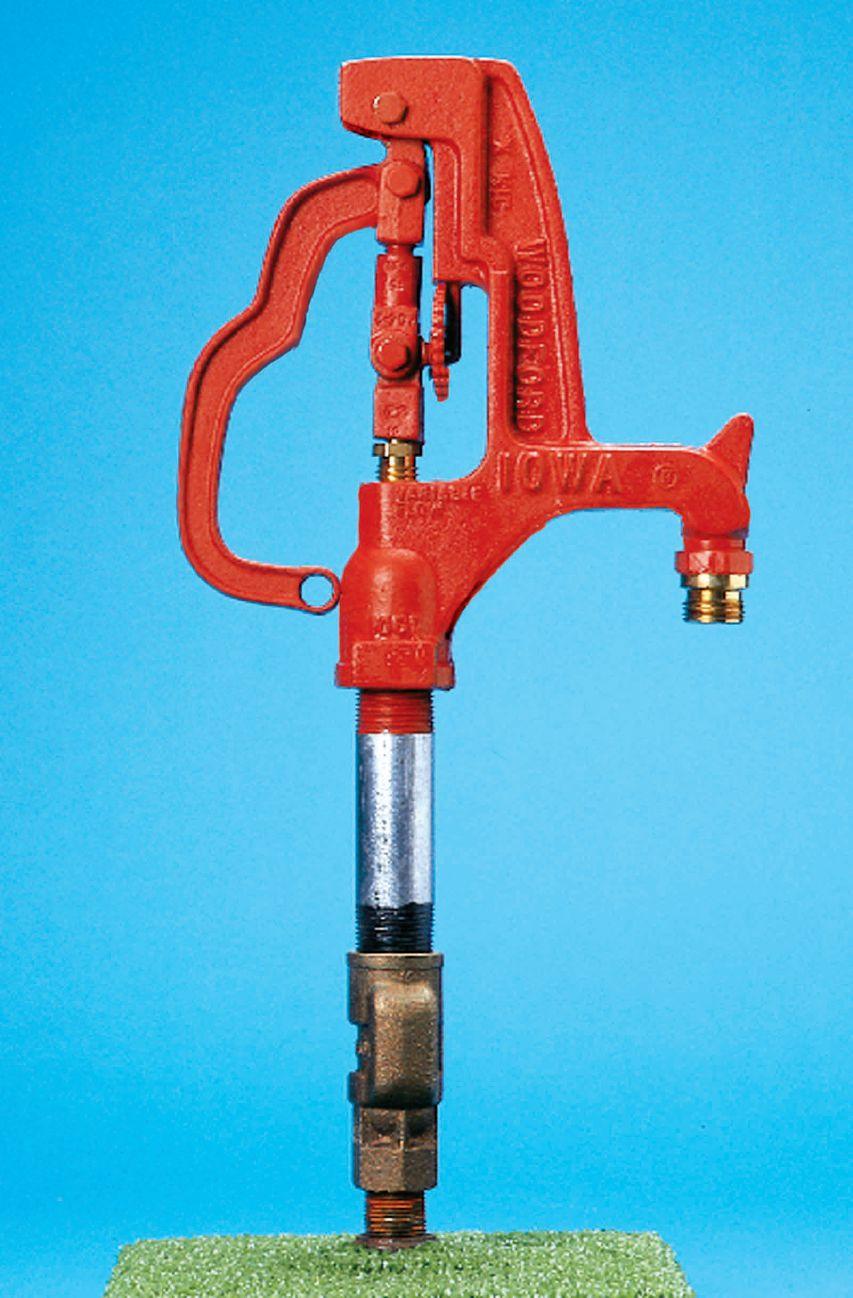
Woodford Model Y34 Freezeless Yard Hydrant
The original. Parts are always available even for the ones made 80 years ago. Includes an adjustable link for lever lock-in tension. A one piece, variable flow plunger has a large cushion type seal to assure shut off even when foreign particles are present. Repairs can be made with hydrant remaining in the ground.



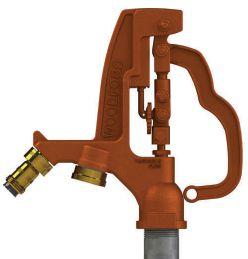
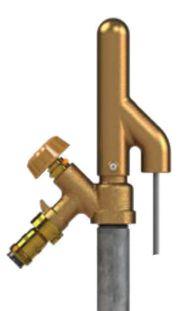

Woodford
Woodford Model Y2
Woodford Model H34
